Things to do in Goa
Goa boasts a number of great attractions for visitors to enjoy while on holiday. This area is of course famous for its gorgeous beaches, but there are many splendid historical sites to see in Old Goa. Visitors can also explore colonial architecture in Margao and Panaji, and browse a vast flea market in Anjuna. The Dudhsagar Waterfall and Dr Salim Ali Bird Sanctuary are popular as well.
The stunning beaches are Goa's most renowned features, though, and visitors will have many excellent options to choose from. Anjuna Beach was once a famous hippie hangout but, today, this beautiful stretch of palm-lined sand has become popular with tourists of all kinds. Baga Beach is great for swimming and a little less crowded than Anjuna, but no less picturesque. Calangute is the busiest and the most commercial beach and, although it is not as lovely as some of the others aesthetically, visitors will enjoy exploring the beach bars, restaurants and shops. Colva is a developed resort area and somewhat blighted by all the hawkers, hotels and hangers-on. However, visitors who walk just a little way can still find beauty and peace along this stretch. Palolem Beach, in the south, is the most unspoilt and natural of Goa's popular beaches, and has retained its laid-back and secluded charm.
The local food is another major attraction as it blends Portuguese and Goan flavours, setting it apart from all other culinary traditions around the country. Goan cuisine is known for delicious fiery flavours, fresh-caught seafood, and an abundance of coconut. Travellers should make a point of trying the state's signature dish, Vindaloo: a mouthwatering, super-hot meat curry made with palm vinegar and dried red chilli peppers.
Although still known as India's party paradise, Goa is a wonderful, relaxing destination to visit with kids on holiday. Children will love the variety of things to see and do, be it renting a bike to explore the local area, catching a boat for some swimming and dolphin watching, or simply enjoying the beaches. Visitors should note, however, that although some hotels or guesthouses may offer childcare services, and this may be tempting, it is strongly advised that they keep their children with them at all times while in a foreign country.
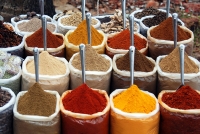
Anjuna Flea Market
Once just a backpacker and hippie hangout selling kaftans and chillums, the Anjuna Flea Market is now more commercial, with a broad range of high-quality goods on sale. Traders fro…
Anjuna Flea Market
Once just a backpacker and hippie hangout selling kaftans and chillums, the Anjuna Flea Market is now more commercial, with a broad range of high-quality goods on sale. Traders from all over India come to sell their wares: Lamani women from Karnataka, dressed in their traditional garb, sell colourful, elaborately woven clothes; Kashmiri stalls display silver and papier-mâché boxes; and Tibetans preside over orderly rows of sundry Himalayan curios. Visitors are expected to bargain but the stall owners tend to be friendly and less pushy than in some other markets.
Website www.india.com/travel/goa/things-to-do/shopping-anjuna-flea-market/
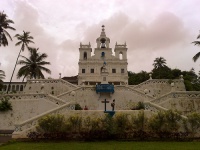
Panaji
This most sedate of state capitals has plenty to offer tourists, and should rightly have a day or two devoted to it on any Indian travel itinerary. Situated on the southern banks o…
Panaji
This most sedate of state capitals has plenty to offer tourists, and should rightly have a day or two devoted to it on any Indian travel itinerary. Situated on the southern banks of the Mandovi River, Panaji only became the capital of Goa in 1843, after the harbour at Old Goa silted up and disease had driven its inhabitants out. The best way to explore the town is on foot, wandering around the old cobbled alleyways, colonial villas, red-roofed houses, taverns and cafes, all of which create the look and feel of a small Portuguese town.
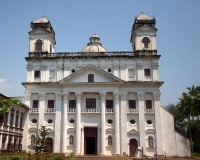
Old Goa
Old Goa was the state's capital city until 1843, when it was moved down river to Panaji. Once a byword for splendour, with a population of several hundred thousand, Old Goa was vir…
Old Goa
Old Goa was the state's capital city until 1843, when it was moved down river to Panaji. Once a byword for splendour, with a population of several hundred thousand, Old Goa was virtually abandoned from the 17th century, as the river silted up and a series of malaria and cholera epidemics drove out the inhabitants. It takes some imagination to picture the once-great capital as it used to be. The maze of twisting streets, piazzas and grand Portuguese villas have long gone. All that remains are a score of extraordinarily grandiose churches and convents. Old Goa has been declared a UNESCO World Heritage Site, and today is the state's main cultural attraction.
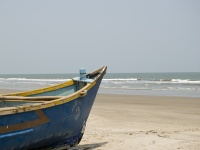
Goa Beaches
Goa has some amazing beaches, and draws a steady stream of local and international tourists. In the north, Anjuna Beach once played host to hordes of hippies, but is now home to a …
Goa Beaches
Goa has some amazing beaches, and draws a steady stream of local and international tourists. In the north, Anjuna Beach once played host to hordes of hippies, but is now home to a number of trendy beach bars as well as the famous Wednesday Market. The new hippie haven, Arambol beach, is also good for dolphin viewing and paragliding. With its white-sand beaches, Agonda in the south is a quiet stretch of beach with a few souvenir stalls and restaurants, while Benaulim Beach, south of Colva, is known for its fishing and laid-back atmosphere. The shady palm trees and soft sands of Palolem Beach, also known as Paradise Beach, are backpacker territory.
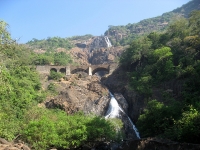
Dudhsagar Waterfall
A great outing in Goa is a trip to the Dudhsagar Waterfall, which is one of the most popular natural attractions in the area. The falls are located in a tropical jungle near the Go…
Dudhsagar Waterfall
A great outing in Goa is a trip to the Dudhsagar Waterfall, which is one of the most popular natural attractions in the area. The falls are located in a tropical jungle near the Goa-Karnataka border, and are surrounded by a network of gently flowing streams and pools. Swimming, hiking and picnicking are popular pastimes at the falls and the deep pool beneath the falls is a favourite nature spot. The waterfalls are among the 100 highest in the world, and visitors who take the difficult climb to the top will be rewarded with breathtaking views of the Western Ghats' wooded mountains.
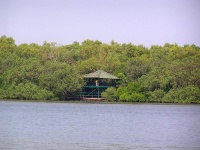
Dr Salim Ali Bird Sanctuary
The Dr Salim Ali Bird Sanctuary is home to around 400 species of birds, both local and migratory. Here visitors can expect to see kingfishers, pintails, coots and egrets, as well a…
Dr Salim Ali Bird Sanctuary
The Dr Salim Ali Bird Sanctuary is home to around 400 species of birds, both local and migratory. Here visitors can expect to see kingfishers, pintails, coots and egrets, as well as a few crocodiles, jackals and foxes inhabiting the mangroves. Although this is one of the smallest bird sanctuaries in Goa, it is among the most famous in India. It is important to go at the right time of year, with the best time to see the migratory birds being after the monsoon season, from October to March. Bird and animal sightings are likely to be better early in the morning.
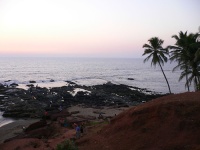
Anjuna
Famed as a hippie hangout since the 70s, the main source of Anjuna's enduring popularity as a holiday destination is its superb beach. Fringed by palm trees, the curve of soft whit…
Anjuna
Famed as a hippie hangout since the 70s, the main source of Anjuna's enduring popularity as a holiday destination is its superb beach. Fringed by palm trees, the curve of soft white sand conforms more closely to the archetypal vision of paradise than any other beach on the north coast. The quieter southern end is protected by rocky outcrops, while to the north the beach widens and stretches for almost a mile past groups of bars, cafés and handicraft stalls. Revellers from the UK and all over India come to Anjuna on holiday, lured by the club scene and the promise of big beach parties (particularly over Christmas and New Year).
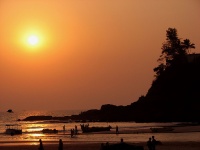
Baga Beach
The Baga Beach holiday resort is a few miles south of Anjuna, and is basically an extension of Calangute. Lying in the lee of a rocky, wooded headland, the only difference between …
Baga Beach
The Baga Beach holiday resort is a few miles south of Anjuna, and is basically an extension of Calangute. Lying in the lee of a rocky, wooded headland, the only difference between this far northern end of the beach and its more congested centre is that the scenery here is marginally more varied and picturesque, and the beach less crowded. It is a good swimming beach but there are no promising breaks for surfers. However, there are lots of other watersports on offer. Hawkers can be an irritation but no more than on most other popular stretches of sand in Goa; a firm 'no' usually does the trick.
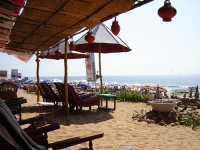
Calangute Beach
Once a peaceful fishing village and then a haven for hedonistic hippies, Calangute is now Goa's busiest and most commercialised holiday resort, a 45-minute bus ride north of the ca…
Calangute Beach
Once a peaceful fishing village and then a haven for hedonistic hippies, Calangute is now Goa's busiest and most commercialised holiday resort, a 45-minute bus ride north of the capital, Panaji. The road from the town to the beach is lined with Kashmiri-run handicraft boutiques and Tibetan stalls selling Himalayan curios and jewellery. The quality of the goods (mainly Rajasthani, Gujarati and Karnatakan textiles) is generally high, but visitors should haggle hard and without being afraid to walk away (the same stuff will crop up again and again). The Calangute beach is nothing special, but is more than large enough to accommodate the huge numbers of holiday visitors.
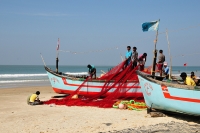
Colva
Colva is the oldest and most heavily developed South Goan holiday resort. The town itself is dotted with colonial-style villas and ramshackle fishing huts, but the beachfront is cr…
Colva
Colva is the oldest and most heavily developed South Goan holiday resort. The town itself is dotted with colonial-style villas and ramshackle fishing huts, but the beachfront is crowded and blighted with unimaginative concrete hotels, snack bars and souvenir stalls. However, it is easy to steer clear of this central area as a spotless and relatively quiet beach is a few minutes' stroll away. Benaulim is only a 30-minute walk to the south, still on Colva beach, and attracts a more upmarket clientele, including British and Indian visitors on holiday. There are many luxury resorts along the coastal stretch, and brightly painted wooden fishing boats litter the beach.
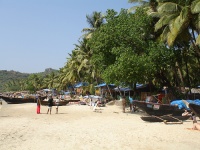
Palolem
For years Palolem remained a secret holiday getaway to all but the most independent traveller. Situated towards the southern tip of Goa, twenty miles south of Margao, it has now be…
Palolem
For years Palolem remained a secret holiday getaway to all but the most independent traveller. Situated towards the southern tip of Goa, twenty miles south of Margao, it has now been discovered, though thankfully, due to strict urban planning restraints, tourism is kept in check. Palolem's crescent-shaped bay is lined with a beautiful white-sand beach and backed with groves of coconut palms. Either side of the bay is a rocky headland covered in thick black forest, and offshore there is a tiny island whose only permanent inhabitants are a colony of black-faced langur monkeys.



